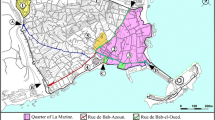Abstract
Brazil has little experience in balanced urban regeneration and historical preservation projects when compared to more mature countries such as the Europeans. However the recent experience of Salvador da Bahia seems to be worth studying. The Pelourinho historic district is a distinguished example of Portuguese Renaissance urban development, hosting colonial architecture typologies from the 16th to the 18th centuries. Since the late 19th century the area has undergone a remarkable decay process being progressively abandoned by economic activities and population. After the area was considered World Heritage by UNESCO in 1985 both municipal and state governments have taken actions to promote its regeneration.
This paper analyses this process considering its implications within the urban design framework. The first part analyses the area morphology as a result of Portugal Colonial policies. The second part assesses degradation as a result of the birth and rise of modern urban planning in Brazil and Bahia. In the next parts the actions of municipal and state authorities are considered as well as their implications considering the economic activities and existing population involved. The conclusion remarks the importance of Salvador experience, establishing its pros and cons.














Similar content being viewed by others
References
Arantes, O., Vainer, C. and Maricato, E. (2000) A Cidade do Pensamento Único: Desmanchando Consensos Petrópolis: Vozes.
Bentley, I. et al. (1985) Responsive Environments: a Manual for Designers Oxford: Butterworth-Heinemman, Ltd.
Butterworth, D. (1981) Latin America Urbanisation. Cambridge: Cambridge University Press.
Cervellati et al. (1977) La Nuova Cultura delle Citta. Milan: Edizioni Scientifiche e Tecnologiche Mondadori.
Couch, C. (1990) Urban Renewal. London: MacMillan.
Elkin, T. et al (1991) Reviving the City: Towards a Sustainable Development. London: Friends of Earth.
Fernandes, A., Sampaio, H. and Gomes, M. (1999) A constituição do urbanismo moderno na Bahia 1900–1950, in Leme, M.C. (org.) Urbanismo no Brasil, 1895–1965 São Paulo: Studio Nobel, pp. 167–182.
Ferrari, C. (1979) Curso de Planejamento Municipal Integrado. São Paulo, Pioneira Editora.
Franklin, B. et al. (1991) Issues in Urban Regeneration: an Annotated Bibliography. Occasional Papers in Architecture and Urban Design, Number 1, School of Architecture, University of Manchester, Manchester.
Hardoy, J. (1982) The building of Latin American cities, in Gilbert, A and Hardoy, J. (eds.) Urbanisation in Contemporary Latin America. Chichester: John Wiley and Sons, pp. 19–33.
Harvey, D. (1989) The Condition of Postmodernity: an Enquiry into the Origins of Cultural Change. Oxford: Blackwell Publishers.
Haughton, G. and Hunter, C. (1994) Sustainable Cities London: Jessica Kingsley Publishers.
IBGE (1982) Censo Demográfico do Brasil 1980. Rio de Janeiro: IBGE.
IBGE (1991) Censo Demográfico do Brasil 1991. Rio de Janeiro: IBGE.
IBGE (2001) Censo Demográfico do Brasil 2000. Rio de Janeiro: IBGE.
IPAC – Instituto do Patrimônio Artístico e Cultural da Bahia (1995) Centro Histórico de Salvador: programa de recuperac¸ão. Salvador: Editora Corrupio.
Instituto Lina Bo P.M. Bardi . (1993) Lina Bo Bardi. São Paulo: Instituto Lina Bo e P. M. Bardi.
Jacobs, J. (1961) The Death and Life of Great American Cities. New York: Random House.
Judd, D. and Parkinson, M. (1990) Leadership and Urban Regeneration. Newbury Park: Sage Publications.
Marx, M. (1980) Cidade Brasileira. São Paulo: Melhoramentos/EDUSP.
Mascaro, J. (1986) A forma urbana e seus custos, in Turkienicz, B. and Malta, M. (eds.) Desenho Urbano: Anais do II SEDUR. São Paulo: Editora Pini, pp. 61–68.
Meurs, P. (1990) Revitalization of the historic center of Salvador da Bahia, Brasil, Delft: The Urban Fabric.
Ottoni, D. and Szmrecsányi, M. (1997) Cidades Jardins: a busca do equilíbrio social e ambiental, 1898–1998. São Paulo, FBSP.
Projeto Editores Associados (1990) Restauro do Mercado Modelo, Projeto, 130: 59–64.
Projeto Editores Associados (1999) Com escadarias e arcadas, novo espaço cultural faz releitura da tipologia do centro histórico, Projeto Design, 233: 48–53.
Reis Filho, N.G. (1968) Contribuição ao Estudo da Evolução Urbana do Brasil. São Paulo: EDUSP.
Reis Filho, N.G. (1970) Quadro da Arquitetura no Brasil. São Paulo: Editora Perspectiva.
Robson, B. et al (1994) Assessing the Impact of Urban Policy. London: HMSO.
Robinson, F. (1989) Urban Regeneration Policies in Britain in the late 1980s: Who Benefits? Discussion Paper Number 94, Centre for Urban and Regional Development Studies, University of New Castle Upon Tyne, New Castle Upon Tyne.
Rodrigues, F. (1986) Desenho Urbano: cabeça, campo e prancheta. São Paulo: Projeto.
Santos Neto, I.C. (1991) Centralidade urbana: espaço e lugar na cidade de Salvador, Unpublished PhD Thesis, FAUUSP – Faculdade de Arquitetura e Urbanismo da Universidade de São Paulo, São Paulo.
SEI (1998) Anuário do Estado da Bahia. Salvador: SEI.
Simões, B. (1988) O elo retomado, Arquitetura e Urbanismo, 18: 38.
Teixeira, M. and Valla, M. (1999) O urbanismo português: séculos XIII – XVIII. Lisbon: Livros Horizonte.
Villaça, F. (1998) Espaço intra-urbano no Brasil. São Paulo: Studio Nobel.
Wipfli, M. (2001) Intervenções Urbanas em Centros Históricos: Estudo de Caso Cidade de Salvador. Unpublished MA Dissertation, FAUUSP – Faculdade de Arquitetura e Urbanismo da Universidade de São Paulo, São Paulo.
Wolf, J. (2000) Iyá Bahia, Arquitetura e Urbanismo 88: 54–56.
Author information
Authors and Affiliations
Corresponding author
Rights and permissions
About this article
Cite this article
Nobre, E. Urban regeneration experiences in Brazil: Historical preservation, tourism development and gentrification in Salvador da Bahia. Urban Des Int 7, 109–124 (2002). https://doi.org/10.1057/palgrave.udi.9000066
Published:
Issue Date:
DOI: https://doi.org/10.1057/palgrave.udi.9000066




